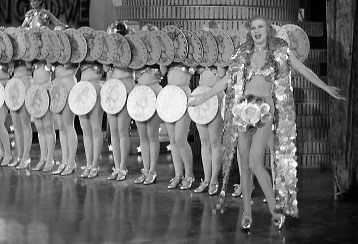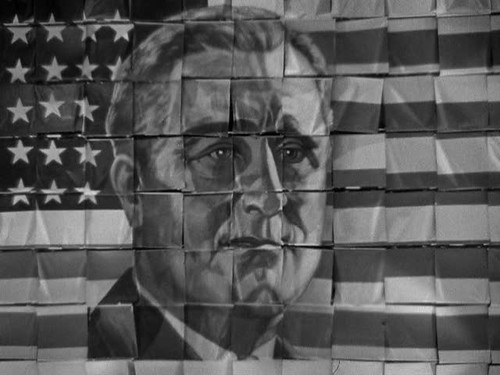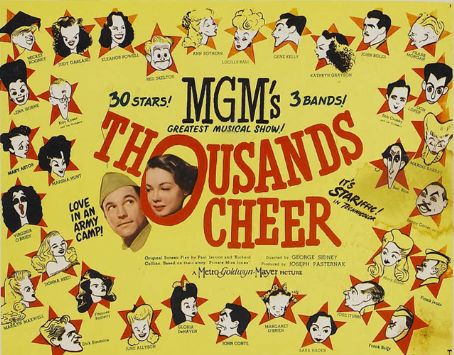Brother Can You Spare a Dime - Movie Musicals and American Turmoil
Even Edison’s – a scientist not an artist – first
film was centred around music and its effect on his male friends. But then,
poor Edison only had the power to create moving images and the beauty of the
sound needed to be inferred rather than experienced. Decades later, brought the
change that audiences needed – talking picture. This new type of movie
experience meant a fan could hear as well as see their favourite star and the
age of the great scriptwriters was born.

The allure of the sparkling sequined costumes,
faced-paced dancing, gleaming smiles and dreamlike backdrops have fascinated
both the movies contemporary audiences and those of today. The actors and
actresses have profited from the new medium – Judy is instantly synonymous with
the bird-like singing and child-like innocence of Dorothy in ‘Wizard of Oz’ and
when the name Fred Astaire is mentioned people immediately think of his light
feat and the complicated choreography of ‘Top Hat’ or ‘Funny Face’.
While watching a couple of my favourite musicals I
noticed something extraordinary. Some, such as, the above mentioned ‘Funny
Face’ or even ‘The Wizard of Oz’ were created simply for entertainment but
others, some forgotten or some less commercial, speak to the audience on a
deeper level. They do this by commenting on the social situation of the period,
offering an escape or simply showing the living standards of the majority of
Americans to create a kind of solidarity. In this filmmakers were using not
only words and faces, but song and dance to communicate and persuade viewers to
see their viewpoint on certain social issues. And this seemed to work. By
removing the serious undertones of the problem, filmmakers were able to reach
more people than before, mainly when discussing the two most serious events in
American history – the Great Depression and World War II.
Exhibit 1# Busby Berkley. Here was a director that
not only had an opinion on the financial and political state of America in the
early 1930’s but vivid imagination and the ability to produce stunning yet
simple musical scenes. Also, it is interesting to note that his dance numbers
showed a need to rebel, such as his a subtle contempt of the institutions that
governed the making of his films, namely the Legion of Decency and the MPPDA.
His great accomplishment was the depression era film, ‘Gold-digger’s of 1933’
(1933) in which nearly all the dance scenes have some political remark either
explicit or implicit. Indeed, within the
first few minutes the viewer is bombarded by the beautiful Ginger Rogers and a
line of scantily clad chorus girls singing, “We’re in the Money” a song
glamorizing the ways of a ‘gold-digger’ and the poverty she faced after the
stock market crash. And, to leave audiences astounded, the final minutes are
filled by Joan Blondell singing (although I hear it was dubbed) the moving
“Forgotten Man” number amongst a backdrop of poverty riddled streets and
homeless men. The song comments on something slightly different from the problems
with the depression but the treatment of army veterans who, when they returned
from World War I, faced high unemployment and little welfare.
 Although, these
are blatant stabs at the wellbeing of ordinary people, the light-hearted song
“Pettin’ in the Park” sung by Ruby Keeler and Dick Powell could also be
interpreted as, in some ways, politically motivated more by the use of its
chorography than its lyrics. It is well known that Busby hated the censors and
the Hays Code that was meant to reduce indecent and violent behaviour from
being shown. In this number, he deliberately goes against the organisation and
depicts images of nude women covered only by a transparent shade and uses
several unconcealed sexual
Although, these
are blatant stabs at the wellbeing of ordinary people, the light-hearted song
“Pettin’ in the Park” sung by Ruby Keeler and Dick Powell could also be
interpreted as, in some ways, politically motivated more by the use of its
chorography than its lyrics. It is well known that Busby hated the censors and
the Hays Code that was meant to reduce indecent and violent behaviour from
being shown. In this number, he deliberately goes against the organisation and
depicts images of nude women covered only by a transparent shade and uses
several unconcealed sexual
Busby was no one hit wonder. As a director, film
after film was filled with social comments, jabs at authority and jokes at the
failing censorship system. I will never forget the
strange image of Franklin D. Roosevelt flashed on the screen during the song
‘Shanghai Lil’ performed by James Cagney and Ruby Keeler in ‘Footlight Parade’
(1933). He was a pioneer but not the only director experimenting with the
musical form.

Busby's great politcal statement in 'Footlight Parade' (1933)
Fast-forward to the early 40’s and America is again
involved in a major world-wide event affecting more than just particular
factions of society but all Americans, World War II.
But this time, instead of rebelling against
authority like their depression-era comrades, these directors followed the
governments lead and used their power to promote nationalism and the importance
of the war to their audiences. Even dramatic stars wanted a piece of the
musical action heading variety-based films made solely to boost the morale of
the anxious nation. Bette Davis and John Garfield, were the leaders of this
movement creating and starring in ‘Thank Your Lucky Stars’ (1943) where famous
actors and actresses would contribute short clips later transformed into a film
with most of the profits were donated to the cause. Most of the scenes were
musical with Bette and even the dapper Errol Flynn singing for the enjoyment of
audiences. After the success of Warner’s film, other studios soon followed with
United Artists releasing its own edition, ‘Stage Door Canteen’ (1943) featuring
Katherine Hepburn and Tallulah Bankhead and MGM’s fluffy ‘Thousand’s Cheer’
also made in 1943.

Viewing
these films today they seem more propaganda than daring, political musicals.
They seem to skim over the harsh realities of the war and attempt to enhance
sentiments of nationalism and pride. But the musicals of the Precode and war
era’s have more in common than just political undertones, they both appear to
capture the emotions and needs of the country at those times. During the 30’s
the people were rebelling, they wanted change and a loosening in the social
strictures – that’s what Busby communicated. During the 40’s, Americans needed
hope, an escape and reassurance that the war was worth the sacrifice and the
musicals boosted and reinforced those desires. Musicals will always be relied upon enliven
the hearts of viewers. Their power lies not only with their beauty and joy but
the uncanny way of speaking on a deeper, more political level without audiences
even knowing it.
Footlight Parade's daring political statement, 'Forgotten Man'
Blink and you will miss it...



In the Depression the people needed to dream and the musical ones were helping to it
ReplyDeleteA good study that more of the seventh position was deserving
Wasn't "Remember My Forgotten Man" at the end of "Gold Diggers Of 1933," not "Footlight Parade"?
ReplyDeleteYou're right!! Its seems strange, because I watch Gold Diggers at least once a week. Its taught not to write late at night. Thanks, I am going to change it now.
ReplyDelete